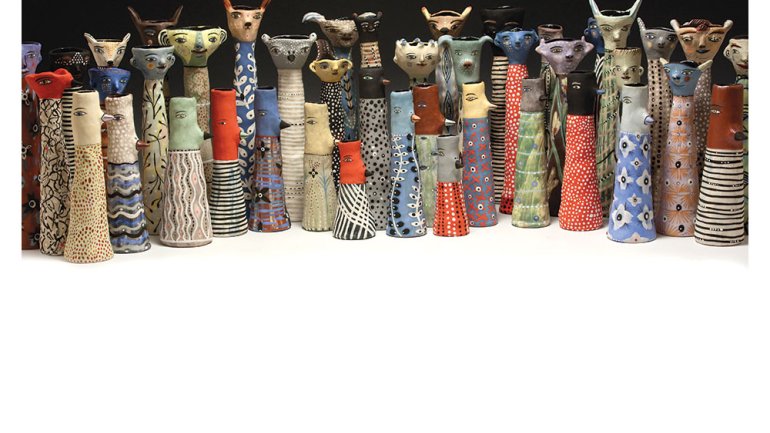The Inside Story
The Inside Story
Jenny Mendes has nothing but praise for her studio-mate.
“He doesn’t bark, and he’s really patient and attentive,” she says of Claude, a handsome white fellow with a big black spot on his rump. “He’s like a little spirit dog.” Claude is always nearby as Mendes forms and meticulously paints her small-scale terracotta sculptures, plates, and other objects in the tiny, jam-packed studio appended to the back of her house in northeastern Ohio.
Growing up in suburban Cleveland, Mendes, 53, always loved making art, but never contemplated it as a career; after high school, art school seemed appealing partly because “I had no idea of what I wanted to do with my life, but that was specific.” She took a clay class at a friend’s enthusiastic urging (the friend quit, she stayed), earned a BFA in ceramics from Washington University in St. Louis – despite a quiet yen for the painting department – and continued learning on a fellowship at Penland School of Crafts in North Carolina in the mid-1980s. By the mid-1990s, she was working full time in clay.
At first, her focus was as much on shaping objects as on painting them, and she would sense her way into a piece through seeing and feeling the clay. But over time, Mendes found herself increasingly engrossed in the content of her work, which was becoming more intricate and colorful.
“A different part of my brain started developing,” she says. In the mid-2000s, she returned to Penland as a resident artist.
These days, she sees herself primarily as a painter. “Now, I have the ability to go into my imagination, see a picture, and then try to find it not in my head,” to re-create that vision on the surface of the clay. Sometimes, an image comes to her as she is waking up or falling asleep “that feels just as alive as what I used to get directly from the clay.”
The result is a translation of her inner world, populated by beings with an almost mythical presence, who invite viewers to create their own stories about them. Fanciful, finely rendered people, imaginary creatures, and animals – sometimes Claude – are often webbed with fine lines and sown with tiny dots.
“My work is very personal and intuitive. When you get that detailed, it’s an intimate experience with yourself,” Mendes says.
She forms her pieces by hand, pinching or coiling them, using just a few tools: “A stick, something sharp, a porcupine quill – I could probably make just about anything work for a tool.”
Brushes, though – that’s another story. “I have tons of brushes. For very fine work, I use a script liner, [size] 18/0. And then, for all other marks, there is always a specific brush for the job. The different brushes feel like friends I can go to when I need just the right shape or flow.” Mendes uses some commercially made underglazes, mostly red, black, and white. Her other colors are terra sigillatas (an ancient slip technique) that she mixes herself, using ceramic stains.
With Claude at her feet, she works slowly but continually in the studio that doubles as the laundry room (“it’s like working in a little nest”), listening to audiobooks or baseball on the radio, resting her eyes on the view of a creek that crosses her five-acre property and the woods beyond.
The house in the country was not the result of any long-cherished dream of rustic life, but rather, as Mendes tells it, almost an impulse buy after she and her husband spotted it while out on a drive. When they bought it, the grounds were wild, the plant life “unstoppable,” she says.
All that lush greenery has given her space to explore another love: growing flowers and vegetables. She especially enjoys the moments when the first green shoots appear, too tiny to tell what they will become – peppers? Peas? Weeds?
“Every day I walk around the garden and look to see what’s changing,” she says. “It’s just paying attention. I want to know what’s going on in there.”
Barbara Haugen is a writer in almost-rural Minnesota and American Craft’s calendar editor.




